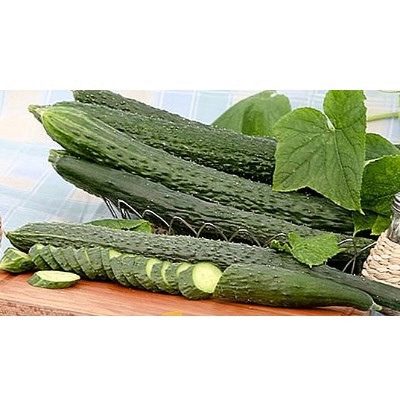
- Authors: S.V. Maximov, N.N. Klimenko, O. V. Baklanova, L.A. Chistyakova (LLC "Agrofirma Poisk")
- Year of approval: 2015
- Growth type: indeterminate
- Branching: the average
- Fruit weight, g: 340-400
- Fruit length, cm: 37-40
- Fruit color: dark green, uniform
- Ripening terms: early
- Fruit shape: elongated-cylindrical
- Scent: fragrant
The Chinese Emperor's cucumber is another worthy example of the work of Russian breeders, a hybrid that can be cultivated with equal success in greenhouses and in the open field. The early ripening variety has excellent immunity and exceptional taste. It is considered a salad, although some sources state that after darkening of the thorns on the shiny green skin, it can also be used for conservation.
Breeding history
Breeders willingly work with Chinese cucumbers, new hybrids appear on the shelves of agricultural firms every year. There are two versions of the Chinese emperor. The first claims that it was bred by domestic breeders, the second - that it is a refined variety, grown for centuries and brought from its historical homeland. Both versions have the right to exist, but some sources insist that the Chinese Emperor hybrid was bred in Russia and has been cultivated here since 2015. It was created at Agrofirma Poisk LLC.
Description of the variety
The hybrid is intended for growing in greenhouses under a film and in the open field. From the moment of emergence to the period of fruiting, it takes from 42 to 45 days, the duration of this period depends on the method, place and climatic conditions in which it is grown. Distinctive features of the variety:
- indeterminacy, long lashes reaching more than three meters in length;
- short ripening times and excellent yield;
- long fruits with a pleasant taste and a persistent aftertaste;
- self-pollination and excellent immunity.
Of the shortcomings, only the need to control the growth of the lashes and buy seeds for each season is called. Like any hybrid, the Chinese Emperor does not produce seed. It must be bought from the originator and preferably in advance, because the variety is in demand among those who are engaged in growing for commercial profit.
Characteristics of the appearance of plants and zelents
The plant has powerful stems that reach considerable height in a short time. They need a mandatory garter, especially at the start of fruiting. If this is not done in a timely manner, the bush may break under the weight of ripening fruits.
The parthenocarpic plant does not need insect pollination, therefore it is more often grown in greenhouse conditions than in open ground. It is difficult to confuse it with other varieties, even in appearance:
- medium dark green leaves grow on long stems and few layers;
- flowers are mixed, bright yellow, there are practically no barren flowers;
- during the fruiting period, the plant is abundantly strewn with thin and long greens.
Cucumbers of this variety are long, with solid flesh without voids, filled with juice, with coarse tuberosity, covered with thorns. During the period of milky ripeness, they are light, but to complete they darken and are practically invisible among the foliage.
Purpose and taste of fruits
The length of the zelents unambiguously makes one assume that they are unsuitable for rolling in the winter, but from the moment the thorns darken, they can be pickled and cooked assorted vegetables, cutting the fruits into pieces. The main purpose is salad. Some people find their taste bland, but in fact, it is delicate, pleasant and delicate. A delicate aroma is felt in any salad, the aftertaste is pleasant and long-lasting.
Maturation
From the moment the sprouts appear, one and a half months can be counted to collect ripe fruits. The variety will bear fruit in the shade and in the sun, the greens grow even, provided that they do not come into contact with the soil. Weight ranges from 340-400 g.
Yield
The average figure is 15.6 kg per square meter. m, but this is not the ultimate dream. The indicator depends on how long the green plant is grown, how correct agricultural technology is used. This figure is given for standard conditions, when irrigation is not carried out every day, but is replaced by loosening the soil.
Growing and caring
Seeds can be planted in two ways: in open ground and seedlings, in special containers or peat pots. Both methods have adherents who are confident that they are planting in the only correct way. Seedling accelerates the ripening period, strengthens the plant. It is better to use it in regions with a harsh climate, so as not to wait for the soil to warm up to the desired temperature.
Before the start of fruiting, watering is recommended at intervals of 3-4 days, from the moment of the start of fruiting, irrigate daily. They feed, alternating organic and mineral fertilizers, at standard times, 2-3 times a season. The plant gratefully responds to each care measure with an increase in yield and taste.

In order to collect strong, tasty and beautiful cucumbers on your site, you need to make top dressing. Lack of nutrients can negatively affect the appearance of the plant and significantly reduce the yield. Fertilize cucumbers with organic fertilizers in combination with mineral fertilizers. With the right balance of these components and adherence to the fertilizing schedule, the cucumber yield will be maximum.

Despite their popularity, cucumbers are often attacked by diseases and pests. From them, cucumber plantings often die before the start of fruiting. In order to prevent this from happening, it is necessary to try to prevent ailments or get rid of them at the very beginning, having studied in detail their causes of occurrence, signs and methods of treatment.





























































































